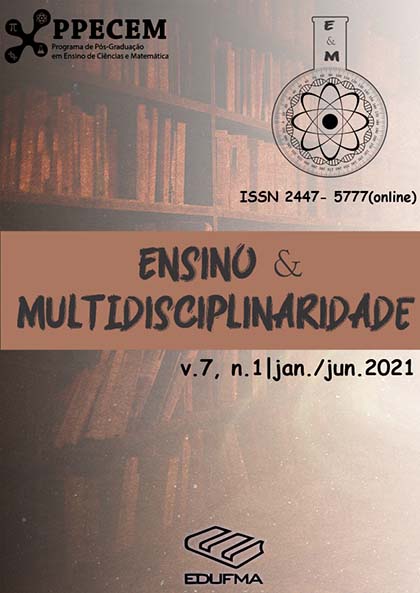Mulheres, flores e suas prisões: reflexões sobre botânica, gênero e ciência com alunas privadas de liberdade
DOI:
https://doi.org/10.18764/2447-5777v7n1.2021.6Palavras-chave:
Ensino de Ciências, Gênero e Ciência, História Cultural da Ciência, Educação PrisionalResumo
Este artigo apresenta uma pesquisa realizada em aulas de ciências desenvolvidas com base na vertente da História Cultural da Ciência com foco nas práticas botânicas durante os séculos XVIII e XIX. A investigação ocorreu junto ao grupo de pesquisa NIEHCC e com alunas privadas de liberdade, quando do estudo de temas do conteúdo de Biologia na Educação de Jovens e Adultos (ecologia, nomenclatura científica, botânica). O recorte histórico suscitou discussões sobre as relações entre gênero e ciência, a partir da discussão da participação feminina na Botânica no recorte histórico selecionado. A pesquisa histórica indicou que as práticas científicas em que as mulheres se envolveram, em geral, eram restritas ao espaço privado e derivaram de um interesse do contato das mulheres com a ciência. O método etnográfico foi escolhido para análise das intervenções em sala de aula. As alunas trouxeram para as aulas temáticas como homossexualidade, machismo, maternidade na adolescência, papel da mulher, diferenças entre os gêneros, opressões, violência masculina no seio familiar e barreiras no acesso da mulher à escola e ao trabalho, apontando que a abordagem da História Cultural da Ciência possibilitou conectar discussões sobre práticas científicas com o contexto das alunas.
Women, flower and their prisons: reflections about botany, gender, science and the social condition of women with female students inmates
Abstract
The paper reports the results of a study carried out in science classes from the Cultural History of Science approach, focusing on Botanical practices during the 18th and 19th centuries. The investigation was carried out with the NIEHCC research group and with students deprived of liberty when studying topics of Biology in Youth and Adult Education's mandatory curriculum (ecology, the scientific terminology, botany). The historical episode aimed to raise discussions about the relations between gender and science with the students, as many women participated in Botany in the selected historical section. The historical research indicated that the scientific practices in which women were involved, in general, were restricted to the private space and derived from an interest in women's contact with science. The ethnographic method was chosen to give voice to the speech of the participating students. Themes as homosexuality, sexism, adolescent motherhood, women's role, gender differences, oppression, male violence within the family, and barriers to women's access to school and work emerged in class, which indicates that the historical discussions were related to the students' context.
Keywords: Science Education; Gender and Science; Cultural History of Science; Prison Education.
Downloads
Metrics
Referências
DARWIN, E. A plan for the conduct of female education, in boarding schools, private families, and public seminaries. Philadelphia: Printed by John Ormrod, n. 41, Chesnut-Street, 1798a. Disponível em: https://archive.org/details/planforconductof00darwrich. Acesso em: 10 jun. 2021.
DARWIN, E. The Botanic Garden: a poem, in two parts. Part I. Containing the economy of vegetation. Part II. The loves of the plants: with philosophical notes. New York: Printed by J. Swords, printers to the faculty of physic of Columbia College, n. 99, Pearl Street, 1798b. Disponível em: https://archive.org/details/thebotanicgarden00darwrich Acesso em: 10 jun. 2021.
DASTON, L. History of Science Without Structure. In: RICHARDS, R. J.; DASTON, L. Kuhn's Structure of Science Revolutions at fifty. Reflections on a Science Classic. University of Chicago Press, p. 115- 132, 2016.
ECKSTEIN, J. John Freeth and his Circle. 1792. Pintura. Disponível em: http://www.bmagprints.org.uk/image/407344/johannes-eckstein-john-freeth-and-his-circle-or-birmingham-men-of-the-last-century. Acesso em: 05 jun. 2021.
GASPAR, A. M. A Representação das Mulheres no Discurso dos Filósofos: Hume, Rousseau, Kant e Condorcet. Uapê: SEAF, Rio de Janeiro, 2009.
GAVROGLU, K. O passado das Ciências como História. Porto Editora, 2007.
GEORGE, S. Cultivating the Botanical Woman: Rousseau, Wakefield and the Instruction of Ladies in Botany. ZpH Jg., v. 12, n. 1, p. 3-11, 2006.
GEORGE, S. Carl Linnaeus, Erasmus Darwin and Anna Seward: Botanical Poetry and Female Education. Science & Education, n. 23, p. 673-694, 2014.
GÉRARD, B. F. Portrait of Louise-Antoinet-Scholastique Gué héneuc, Madame la Maréchale Lannes, Duchesse de Montebello, with her children. 1814. Pintura. Disponível em: https://artsandculture.google.com/asset/portrait-of-louise-antoinette-scholastique-gu%C3%A9h%C3%A9neuc-madame-la-mar%C3%A9chale-lannes-duchesse-de-montebello-with-her-children/EwFZgTIu7_f12g. Acesso em: 09 jun. 2021.
GÉRARD, M. Lady reading in a interior. 1795. Pintura. Disponível em: https://commons.wikimedia.org/wiki/File:Marguerite_G%C3%A9rard_-_Lady_Reading_in_an_Interior_-_WGA8609.jpg. Acesso em: 21 jun. 2021.
GÉRARD, M. Sleep my child. 1783. Pintura. Disponível em: https://es.wikipedia.org/wiki/Marguerite_G%C3%A9rard#/media/File:Marguerite_G%C3%A9rard_-_Sleep_my_child.jpg. Acesso em: 18 jun. 2021.
GIANQUITTO, T. “Good observers of nature”: American women and the scientific study of the natural world, 1820-1885. Athens: University of Georgia Press, 2007.
GOULD, John. A century of birds from the Himalaya Mountains. London, 1831. Disponível em: https://archive.org/details/centurybirdsfro00Goul Acesso em: 05 jun. 2021.
GRONIM, S. S. What Jane Knew: A Woman Botanist in the Eighteenth Century. Journal of Women`s History, v. 19, n. 3, p. 33-59, 2007.
JACSON, M. Botanical Dialogues: Between Hortensia and her Four Children, Charles, Harriet, Juliette and Henry. London, printed for J. Johson, in St. Paul's Church-Yard, 1797. Disponível em: https://archive.org/details/b28762514. Acesso em: 04 dez. 2021.
JAGER, I. Discutindo gênero com mulheres privadas de liberdade: um olhar da história cultural da ciência para o desenvolvimento da botânica nos séculos XVIII e XIX. Dissertação (Mestrado em Ciência, Tecnologia e Educação) - Centro Federal de Educação Tecnológica Celso Suckow da Fonseca, 2018.
JAGER, I. T.; MELLO, A. L. ; FERREIRA, M. ; GUIMARAES, R. . Quem são elas e o que querem? Perfil de mulheres privadas de liberdade alunas da Educação de Jovens e Adultos de um presídio carioca. Revista Educação e Cultura Contemporânea, v. 18, n. 53, p. 182-203, 2021.
JARDIM, W. T.; GUERRA, A. República das Letras, Academias e Sociedades Científicas no Século VIII: A Garrafa de Leiden e a Ciência no Ensino. Caderno Brasileiro de Ensino de Física, v. 34, p. 774-797, 2017.
LOIZOS, P. Vídeo, filme e fotografias como documentos de pesquisa. In: BAUER, M., W; GASKELL, G. Pesquisa qualitativa com texto, imagem e som: um manual prático. Rio de Janeiro: Vozes, p. 137- 155, 2015.
LOUDON, J. W. Ladies' Flower-Garden of Ornamental Greenhouse Plants. London: William Smith, 1841. Disponível em: https://archive.org/details/gardladiesflower00loudrich. Acesso em: 30 jun. 2021.
MATTOS, C. L. G.. A abordagem etnográfica na investigação científica. In: MATTOS, C. L. G.; CASTRO, P. A. (Orgs.) Etnografia e educação: conceitos e usos. Campina Grande: EDUEPB, p. 49-83, 2011.
MINZON, C.; DANNER, G. K.; BARRETO, D. J. Sistema Prisional: Conhecendo as vivências da mulher inserida neste contexto. Akrópolis, Umuarama, v. 18, n. 1, p. 71-81, 2010.
MOURA, C. B. de; GUERRA, A. História Cultural da Ciência: um caminho possível para a discussão sobre as práticas científicas no Ensino de Ciências? Revista Brasileira de Pesquisa em Educação em Ciências, v. 16. n. 3. p. 725–748, 2016.
MOURA, M. J. de; FROTA, M. H. de P. Dilacerando os fios, tricotando às avessas, construindo a trama: mulher, tráfico de drogas e prisão. Revista Público e o Privado, n. 8, 2006.
MUZZIN, L. Education and Science. In: RESTIVO, S. Science, Technology, and Society. An Encyclopedia. Oxford Press, p. 98-105, 2005.
OLIVEIRA, A. Algumas pistas (e armadilhas) na utilização da Etnografia na educação. Educação em foco, ano16, n. 22, p. 163-183, 2013.
OLIVEIRA, R. D. V. L. de; QUEIROZ, G. R. P. C. O cotidiano, o contextualizado e a Educação em Direitos Humanos: a escolha de um caminho para uma educação cidadã cosmopolita. In: OLIVEIRA, R. D. V. L. de; QUEIROZ, G. R. P. C. (Org.). Tecendo Diálogos sobre Direitos Humanos na Educação em Ciências, p. 61- 98, 2016.
ORTEGA, C. G. Instrucción sobre el modo más seguro y económico de transportar plantas vivas por mar y tierra á los países más distantes: ilustrada con láminas. Añádese el metodo de desecar las plantas para formar herbarios; dispuesta por orden del rey. Madrid: D. Joachin Ibarra, 1779. Disponível em: http://bibdigital.rjb.csic.es/ing/Libro.php?Libro=3732. Acesso em: 06 maio 2021.
PAGE, J. W; SMITH, E. L. Woman, literature, and the domesticated landscape: Englad's disciples of Flora, 1780-1870. Cambridge University Press, 2011.
PIMENTEL, J. La Revolucíon Científica. In: Artola, M. (dir.) Historia de Europa: Tomo II. Madrid: Espasa Calpe, p. 163–238, 2007.
PIMENTEL, J. ¿Qué es la historia cultural de la ciencia? Arbor, v. 186, n. 743, p. 417-424, 2010.
REYNOLDS, J. Joseph Banks. 1773. Pintura. Disponível em: https://en.wikipedia.org/wiki/Joseph_Banks#/media/File:Joseph_Banks_1773_Reynolds.jpg. Acesso em: 29 maio 2021.
SHEFFIELD, S. L. Women and Science: Social Impact and Interaction. Rutgers University Press, 2006.
SHTEIR, A. Botanical Dialogues: Maria Jacson and Women's Popular Science Writing in England. Eighteenth-Century Studies, v. 23, n. 3, p. 301-317, 1990.
SHTEIR, A. “She comes! - The Goddess!”: Narrating Nature in Erasmus Darwin's The Botanic Garden. In: LEHLEITER, C. Fact and fiction: literary and scientific cultures in Germany and Britain. University of Toronto Press, 2016.
SIGRIST, R.; WIDMER, E.. D. Training links and transmission of Knowledge in 18 th century botany: A social network analysis. Revista hispana para el análises de redes sociales, vl. 21, n. 17, 2011.
Downloads
Publicado
Como Citar
Edição
Seção
Licença
Autores que publicam nesta revista concordam com os seguintes termos:
a. Autores mantém os direitos autorais e concedem à revista o direito de primeira publicação, com o trabalho simultaneamente licenciado sob a Licença Creative Commons CC BY que permite o compartilhamento do trabalho com reconhecimento da autoria e publicação inicial nesta revista.
b. Autores têm autorização para assumir contratos adicionais separadamente, para distribuição não-exclusiva da versão do trabalho publicada nesta revista (ex.: publicar em repositório institucional ou como capítulo de livro), com reconhecimento de autoria e publicação inicial nesta revista.
c. Autores têm permissão e são estimulados a publicar e distribuir seu trabalho online (ex.: em repositórios institucionais ou na sua página pessoal) após a publicação final do manuscrito.




















